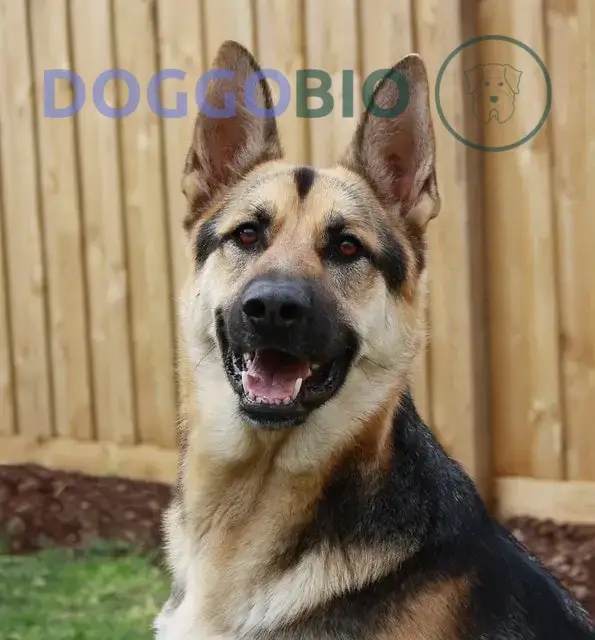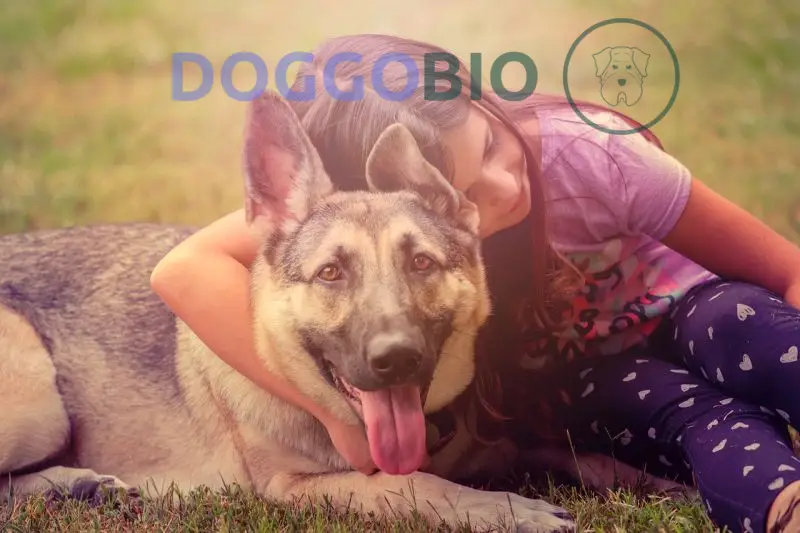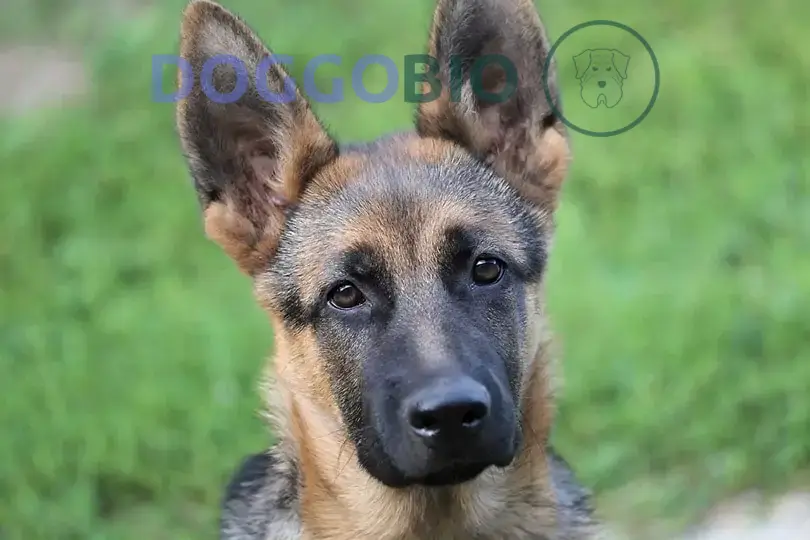Welcome to the canine elegance and efficiency world – the Short Haired German Shepherd. With a distinctive appearance that marries sleekness and strength, this remarkable breed exemplifies the perfect blend of form and function. Renowned for their intelligence, versatility, and striking presence, Short Haired German Shepherds captivate the hearts of dog enthusiasts and working professionals alike.
In this exploration, we delve into the origins, characteristics, and unique qualities that set the Short-Haired German Shepherd apart, uncovering the captivating story behind this exceptional canine companion. Whether you’re a devoted dog lover or simply curious about the world of canine diversity, join us as we unravel the tale of the Short-Haired German Shepherd. This dog breed embodies both beauty and utility in every graceful stride.
A Brief Overview of Short haired German Shepherd
| Characteristic | Range |
| Height | 22 – 26 inches |
| Weight | 50 – 90 pounds |
| Lifespan | 7 – 10 years |
| Colors | Various (e.g., black and tan, black and red, grey, black, white) |
| Suitability | Active families, singles, couples, those with a large backyard |
| Temperament | Intelligent, loyal, energetic, highly trainable, protective, versatile |
What is a Short haired German Shepherd?

A short haired German Shepherd is another term for your classic German Shepherd dog (GSD). When you envision a GSD, this coat length usually comes to mind. Some dog parents even call them “short-haired” because their coats are shorter compared to the long-coated variations of the breed.
Short-coat or “regular” German Shepherd coats result from a dominant gene, while the long-coated gene is recessive. Long-haired Shepherds do exist, but both the AKC and UKC standards emphasize one coat length, as we mentioned earlier: medium.
Those fluffier pups that don’t quite meet the long-coated GSD criteria are sometimes playfully dubbed “plush” Shepherds. Coats that are overly long or excessively short are considered imperfections.
What is the difference between a long-haired German Shepherd and a short-haired one?
The most apparent distinction between these two Shepherds is their coat length. Your standard German Shepherd boasts a dense, medium-length coat that might seem slightly longer around the neck and hind legs.
Conversely, the long-haired German Shepherd showcases hair that drapes or cascades almost unconsciously from the body. The texture can take on a wooly or wavy look, deviating from the norm.
| Characteristic | Long Hair German Shepherd | Short Hair German Shepherd |
| Rarity | 15% of all GSDs | 85% of all GSDs |
| Coat Type | Single | Double |
| Coat Protection | Less suitable for cold | Excellent insulation and waterproofing |
| Coat Length | Over 2 inches | Up to 1 inch |
| Purpose | Companion dogs | Working dogs |
| Purity | Purebred | Purebred |
| AKC/UKC Recognition | No | Yes |
| Price Range | $500-$1,000 | $500-$1,500 |
Interesting Facts about Short haired German Shepherd
1. They Have a Short History.
Although they are now globally recognized as one of the most iconic dog breeds, German Shepherds have a surprisingly recent origin. It was in the late 1890s, thanks to the efforts of Max von Stephanitz, that the German Shepherds we know today began to take shape. The title of the very first officially registered German Shepherd goes to a dog named Horand.
2. AKC recognize them
Once Stephanitz set the breed standard and German Shepherds gained popularity, the American Kennel Club (AKC) formally recognized the breed in 1908.
3. They have various names.
The Short Haired German Shepherd, often recognized as the standard German Shepherd or just GSD, is also known by various monikers.
In Germany, they bear the name Deutscher Shaferhund, while in the U.S, they were initially referred to as the “Shepherd Dog.”
During World War I and II, folks on both sides of the Atlantic aimed to detach the “German” label due to its connotations. Consequently, the dog acquired the name Alsatian across most of Europe.
4. Ranks of the brainiest canines
German Shepherds have earned themselves a prime spot in the ranks of the brainiest canines. Their intelligence is renowned, and it’s not just hearsay – in the definitive guide to dog smarts, “Intelligence of Dogs,” by Stanley Coren, German Shepherds snagged the third position. Only the Poodle and the Border Collie outshined them in this canine IQ contest.
5. Second spot for the most beloved dog breed
As per the AKC, German Shepherds have held steady in the second spot for the most beloved dog breed in the United States since 2014.
They’re only outranked by the ever-popular Labrador Retriever, a family favorite. This surge in popularity can largely be attributed to the breed’s versatility – they’re utilized for a wide range of tasks and are also cherished as treasured family companions.
6. They Played Roles in Global Conflicts.
German Shepherds didn’t sit on the sidelines during the World Wars – they were right there in the action. In World War I, these remarkable dogs served on multiple fronts, aiding the Germans and the Allied forces. Their tasks ranged from delivering crucial messages and distributing sustenance to acting as rescue dogs and personal protectors. Their capabilities left a lasting impression on soldiers post-war.
And when World War II rolled in, German Shepherds were again on duty, proving their worth on both sides. These versatile dogs weren’t just bystanders – they played pivotal roles in the historical landscape.
7. They’re the Celebrities of Tinseltown.
German Shepherds have been gracing the silver screen for ages, assuming leading roles in numerous Hollywood blockbusters. One dog that stole the show was Rin Tin Tin – an actual household name, headlining countless movies during the early 1900s.
Not to be outshone, Strongheart, another iconic GSD, emerged as one of the earliest stars of the breed. Strongheart made his mark in the world of cinema with a debut appearance in the 1921 outdoor adventure flick titled “The Silent Call.”
8. They Pioneered Guide Dog Assistance.
When it comes to aiding individuals with visual challenges or total blindness, dogs take the lead. While Labradors and Golden Retrievers have taken center stage recently, German Shepherds were among the initial pioneers.
What does a Short haired German Shepherd look like?

Size, height, and Weight
In Short Haired German Shepherds, males stand slightly taller than their female counterparts.
These four-legged companions fall within the medium to extensive range, boasting muscular physiques that grant them strength without unnecessary bulk.
| Characteristic | Male | Female |
| Size Category | Medium-large | Medium |
| Height Range | 24-26 inches | 22-24 inches |
| Weight Range | 65-90 pounds | 50-70 pounds |
Coat colors and Types
While the iconic black and tan German Shepherd is undoubtedly the hue that immediately springs to mind, these canines don’t limit themselves to just one color scheme. They flaunt a diverse range of 11 distinct colors.
While many of these color combinations are commonly spotted, a few are exceptionally rare, such as liver and blue variations, the intriguing “panda” pattern, and the captivating red hue.
Temperament and Personality
The personality of a Short Haired German Shepherd is influenced by its owner and surroundings, resulting in a range of characters. However, as a rule of thumb, they tend to be loyal, protective, and highly intelligent companions, crafting them into outstanding pets.
Training and Exercise Requirements
Short Haired German Shepherds flaunt an impressive intellect, rendering them quick learners and a breeze to train. They effortlessly shine in disciplines like obedience, tracking, and protection training, often serving as evidence of their sharp minds.
However, these pups aren’t just brainy – they’re also high-octane regarding physical activity. To maintain harmony, a daily dose of 2 hours of exercise is the golden ticket to expel their pent-up energy. Should this requisite be neglected, boredom may set in, potentially leading to some less-than-desirable destruction.
Grooming and Cleaning
Grooming Tips for German Shepherds
- Brush your German Shepherd weekly, especially during shedding seasons.
- Keep their nails trimmed to prevent discomfort and posture issues.
- Bathe them as needed to preserve their coat’s natural moisture.
- Regularly clean their teeth and ears.
- Maintain a flea prevention program for their well-being.
Food and Diet
Regarding their culinary preferences, Shor Haired German Shepherds thrive on a diet rich in protein and low in carbohydrates. To ensure their well-being, spreading their sustenance across two meals daily is advised – this prevents overindulgence in one go. Dry kibble emerges as the prime choice of nutrition, catering to their nutritional needs.
And, of course, let’s remember the essential: a continuous supply of pristine water to keep them well-hydrated.
Life Expectancy and Common Health Issues
In the realm of lifespans, Short Haired German Shepherds, being of medium to immense stature, usually clocking in at around 10 years. However, this timeline might appear somewhat modest compared to their counterparts of similar size.
German Shepherds have been meticulously bred to adhere to the exacting breed standards, inadvertently giving rise to a history of substantial inbreeding. Consequently, the breed has encountered various health challenges over the years.

Hypothermia
Long-haired GSDs sport a single coat that could be more proficient at insulating against the cold. Consequently, they can battle hypothermia (extreme chilling) in low temperatures.
Hot Spots
Hot spots, or acute moist dermatitis, arise when a pup’s skin irritates and oozes a bloody discharge.
Tangled Hair Woes
Long-haired German Shepherds are more inclined to tangles and mats forming in their fur, which can be discomforting to remove.
Joint Dysplasia
Hip and elbow dysplasia occurs when thigh and leg bones don’t snugly fit into their respective hip sockets and elbow joints.
Epilepsy
While epilepsy can affect any dog breed, German Shepherds are highly susceptible to this neurological disorder, leading to seizures.
Blood Disorders
Blood-related ailments are relatively prevalent among GSDs. Notably, Von Willebrand’s disease and hemophilia A are notable blood disorders that can occur.
How Much is a Short haired German Shepherd?

When considering the Short Haired German Shepherd, it’s important to note that their price can vary significantly, falling within the range of $500 to $1,500.
List of dogs that are similar to Short haired German Shepherd
Frequently Asked Questions
Does AKC Recognize Short Haired German Shepherd?
Yes. Short-haired Shepherds are the quintessential German Shepherds and can wholeheartedly compete and be registered, as long as their fur isn’t oddly short. Nevertheless, a few color variations pose challenges. For instance, pale, blue, and liver hues are regarded as faults, and white is a no-go color that disqualifies them.
Conversely, long-haired German Shepherds must align with the breed standard, as a long coat is seen as a shortcoming. As a result, these dogs aren’t eligible for the spotlight of the show ring.
Are Short Haired German Shepherds Rare?
No, short-haired GSDs are not rare. They are standard compared to their long-coated counterparts.
The gene responsible for long hair in German Shepherds is recessive, while the gene for the standard short coat is dominant. Dominant traits tend to be more prevalent in most gene pools, leading to a higher occurrence of short-coated GSDs.
Do German Shepherds Have a Double Coat?
Yes, all German Shepherds are expected to have a double coat, per AKC and UKC standards. This means they should possess a dense, straight outer coat that lies close to their body, unlike breeds like Samoyeds known for fluffiness. Additionally, their undercoat should be shorter but densely packed, covering the entire body.
However, it’s worth noting that long-haired German Shepherds may occasionally have a thinner undercoat. While this isn’t a major concern in moderate climates, it can affect their comfort in colder regions, as the undercoat provides vital insulation against the cold. So, long-haired GSDs in chilly areas might struggle to stay warm without a robust undercoat.
Do Short-Haired GSDs shed more than Long-Haired Ones?
Yes. This is because most short-haired shepherds come complete with an undercoat, which leads to more shedding than their longer-coated counterparts, who might need more underlayer.
It’s a fact that during shedding seasons, a bit more brushing is for these short-haired pals to tackle the loose undercoat. And in case you were wondering, the same rule applies to long-haired GSDs who boast an undercoat.
Are Short Haired German Shepherds hypoallergenic?
No Short Haired German Shepherds don’t fall into the hypoallergenic category.
These charismatic canines come with a side of shedding, leaving behind their furry traces throughout your living space. In addition, they release dander along with their fur, rendering them unsuitable for individuals with allergies.
Do all German Shepherds have the same personality?
Yes, when it comes to personality, there’s no disparity between Long-Haired and Short Haired German Shepherds. The sole divergence lies in their coat length – that’s it. Both types share an equal dose of loyalty, intelligence, and the knack for being fantastic family members.
Conclusion
In conclusion, the Short Haired German Shepherd exemplifies the blend of elegance and utility. From its origins as a versatile herding dog to its roles as a loyal companion and diligent working partner, this breed embodies intelligence, loyalty, and adaptability.
The Short Haired German Shepherd symbolizes the enduring connection between humans and dogs, leaving an indelible mark on hearts and history, whether by your side at home or in the field.

Pingback: Sable German Shepherd: Canine Beauty Emblem 2024
Pingback: Great Pyrenees German Shepherd Mix: Hybrid Harmony 2024